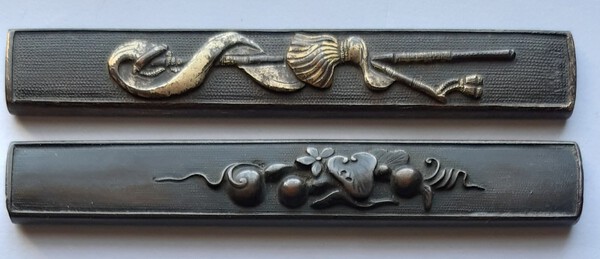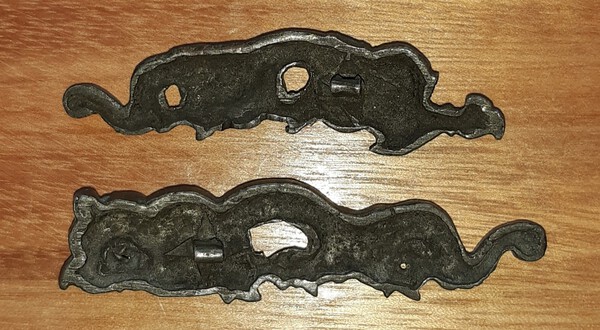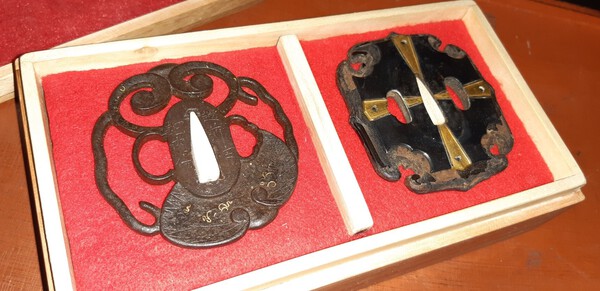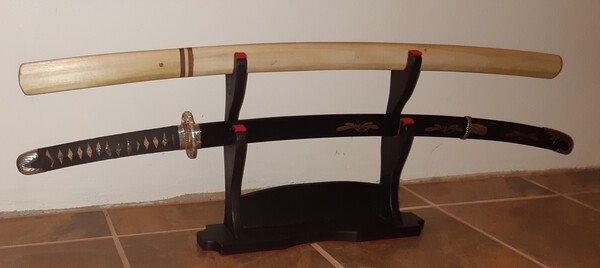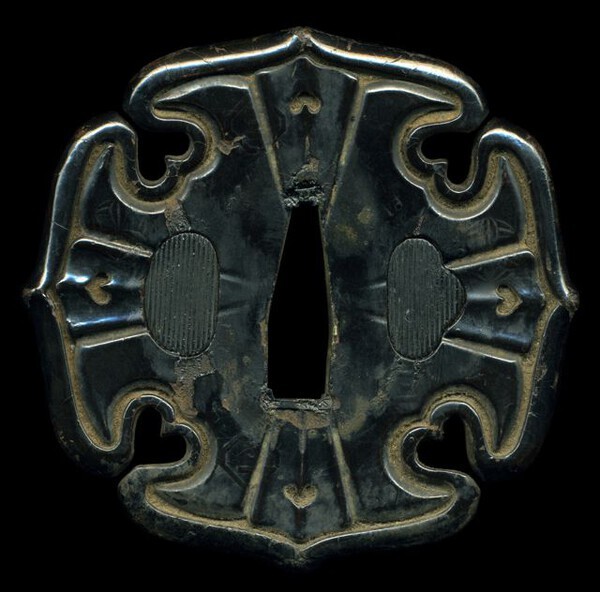
Janrudolph
Members-
Posts
252 -
Joined
-
Last visited
Profile Information
-
Gender
Male
-
Location:
South Africa
-
Interests
I have never been a specialist collector, as my interests are very wide. They range from numismatics through military history to edged weapons and firearms.
Profile Fields
-
Name
Johan van Zyl
Recent Profile Visitors
The recent visitors block is disabled and is not being shown to other users.
Janrudolph's Achievements
-
Thank you so much, Piers and Florian! It seems first choice falls on the saihai kozuka. I think the only uncertainty I now have, is as to the probable age of that kozuka. What more can be said, besides that it is simply Edo? Early...late? Regards Johan
-
This pic show the reverse of the two kozuka. Small dent on the lower kozuka. Looking back at the top picture, the blade nakago of the lower kozuka is quite long and seems to belong to the kozuka, but I'm not sure of the top blade, whether it might have been exchanged. The bottom blade has a signature suggested to be "Seki Kanemoto", but the top blade signature is still unknown. If with my own arthritic fingers (!) I'm going to attempt the big job of crafting a super kiri box, which of these two kozuka is best deserving to get mounted? Regards Johan
-
Most of you will recognize the top design to be a saihai. The bottom one I have not identified yet. I need help with that, please.
-
Good day friends. I would like you to help me choose the best, most worthy kozuka out of the three I possess, in order to make a traditional kiri box for it. Please see pictures of two of these. (The third is certainly interesting, but unfortunately too damaged to consider.) Johan (More pics to come)
-
Thank you very much, Brian! Much appreciated. Regards Johan
-
So do you think one can tell from the pictures that they are edo or repro? Regards Johan
-
I tried having a friend look the menuki over with a hand-held XRF scanner, and he said they were mostly copper. I can only guess that might mean Shibuichi. So I am eager to ask if you guys think this pair might date back to Edo, or should I be satisfied they are a modern reproduction? I'm including a picture taken of the menuki turned around. My friend sounded quite knowledgeable when he said the little studs visible at the back showed them to be genuine. This pic brings the colour out much better. Regards Johan
-
Good day friends. I have been absent for some time, but not inactive regarding my much-researched katana! I have here a pair of menuki that the previous owner obtained at auction a while ago. It accompanied an Edo period iron tsuba signed "Echizen (no) Ju" and "Kinai Saku". I have both now, and I am entertaining the notion that the pair of menuki might also be Edo, especially since they and the tsuba were taken off the same katana. Let the pictures speak. Regards Johan
-
Home-made accessories for nihonto
Janrudolph replied to Janrudolph's topic in General Nihonto Related Discussion
Thee following pic shows the shirasaya that I drew my inspiration from. It is in the book War in the Pacific, and shows the shirasaya belonging to Gen Hideki Tojo, who you will know was Prime Minister and War Minister of Japan, WWII. At 40 cm long it is the largest photograph I could find with which to take measurements from, as I had no way of getting my hands on a real shirasaya to use as a model. -
Home-made accessories for nihonto
Janrudolph replied to Janrudolph's topic in General Nihonto Related Discussion
That's affirmative, Rich. I used what was left over of the poplar wood I procured for the shirasaya. In making the shirasaya, I thought of bringing in a small improvisation to serve as my signature feature, by adding the two dark brown spacers as a koiguchi and to lie next to the fuchi. I though the contrast would look nice. Shortly thereafter I chanced to see a nihonto in shirasaya having exactly the same two dark spacers as mine. And I thought I was being original! Johan -
Home-made accessories for nihonto
Janrudolph replied to Janrudolph's topic in General Nihonto Related Discussion
The top pic you will recognise as a double kiri box. I made it to hold and preserve my mini-collection of tsuba. Underneath there is a compartment for some documentation, with the purpose of identifying the tsuba for a viewer. The left one is a signed iron Echizen (no) Ju Kinai Saku, made by the 6th generation (rokudai) of the Takahashi family. The design is of a single aoi leaf and stalks. The tendrils are inlaid kin zogan. Clues point to this tsuba to have been made between 1809 and 1821. The one on the right is a nerikawa tachi tsuba with a classic aoi hollyhock-shape and inome sukashi (boar's eye openwork similar to a heart shape). On the single o-seppa there appears a motif repeated four times, bearing at each end an inome (representing vigilance, so I am led to believe). The o-seppa is shakudo and the cross motif is gold. I believe it was made sometime between 1800 to 1867. PLease consider when reading what I have said about the two tsuba, that I am not stating proven facts. But having read up extensively and hearing forumites' opinions, these are the only conclusions I can arrive at. In stating my views on these two tsuba, I am making it easy for any of you guys to voice your difference in opinion. Please do come in and comment - I have not stopped learning yet! Bottom pic: Forumites have suggested I should put my Nobuyoshi katana in shirasaya. Only way I could do that is to make it myself. I used poplar wood and spent seven weeks at my work bench trying my utmost to get the thing perfect. I am happy with the end result, but not so happy with what the constant repetitive handwork it took to make the shirasaya caused to my right hand: I developed painful carpal tunnel syndrome and a trigger finger. I might have to have it surgically fixed. But the shirasaya project is done! Of course I also had to make a wooden blade to hold the koshirae together, and the stand to exhibit the set. Regards. Johan -
Home-made accessories for nihonto
Janrudolph replied to Janrudolph's topic in General Nihonto Related Discussion
-
Good day friends. I would very much like to show you two pics. Please see below. Johan
-
Barry, looking at the last post you wrote made me realise I'm speaking to a big, big man. If I could, I'd call up Scotty to transport me magically to your place "down under" so I can have a beer with you and have the privilege of shaking your hand! In the meantime I have been busy looking for more nerikawa tsuba looking like mine, and I came upon these two (please see below). The first one looks like mine because of the utterly poor condition of the lacquer, however, mine also has the four boar's eye cutouts in addition; and the second because of the cross design which looks much the same as the silver (?) Art Museum tsuba and my tsuba's single o-seppa. The first one was posted in 2014 by a member called Jason, and the second by Boris Markhason, posted by Marius in that same year. The second one is said to date to the Momoyama to early Edo period (c. 1590-1650). It consists of four layers of leather which have been carved and assembled to mimic a classic aoi tachi tsuba with o-seppa. What about the first one's date? Well, Boris has said that the vast majority of preserved nerikawa tsuba date to the late Edo period. Edo is 1603 - 1867, so late Edo runs up to 1867. Now, I think what is plausible for the first one is plausible for mine too, so I think my nerikawa tsuba was crafted not later than 1800-1867. That makes it older than 153 years, but probably not older than 220 years. This time span could account for the deterioration in condition it suffered. I'd want to go for 220 years or older even, because I really do think that the level of deterioration I see is profound and genuine. Think I'm imagining things, you all? Well, shoot me down in flames with sound reasoning. Johan



